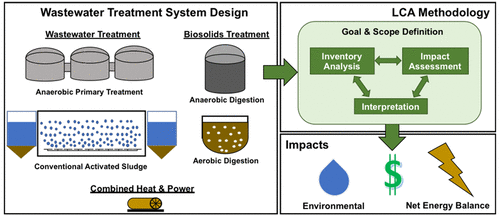当前位置:
X-MOL 学术
›
Environ. Sci. Technol.
›
论文详情
Our official English website, www.x-mol.net, welcomes your
feedback! (Note: you will need to create a separate account there.)
Lifecycle Comparison of Mainstream Anaerobic Baffled Reactor and Conventional Activated Sludge Systems for Domestic Wastewater Treatment
Environmental Science & Technology ( IF 10.8 ) Pub Date : 2018-09-05 , DOI: 10.1021/acs.est.7b06684 Andrew R. Pfluger 1, 2 , Jennie L. Callahan 1, 2 , Jennifer Stokes-Draut 1, 3 , Dotti F. Ramey 1, 2 , Sonja Gagen 1, 4 , Linda A. Figueroa 1, 2 , Junko Munakata-Marr 1, 2
Environmental Science & Technology ( IF 10.8 ) Pub Date : 2018-09-05 , DOI: 10.1021/acs.est.7b06684 Andrew R. Pfluger 1, 2 , Jennie L. Callahan 1, 2 , Jennifer Stokes-Draut 1, 3 , Dotti F. Ramey 1, 2 , Sonja Gagen 1, 4 , Linda A. Figueroa 1, 2 , Junko Munakata-Marr 1, 2
Affiliation

|
The objective of this study was to evaluate the lifecycle impacts of anaerobic primary treatment of domestic wastewater using anaerobic baffled reactors (ABRs) coupled with aerobic secondary treatment relative to conventional wastewater and sludge/biosolids treatment systems through the application of wastewater treatment modeling and three lifecycle-based analyses: environmental lifecycle assessment, net energy balance, and lifecycle costing. Data from two pilot-scale ABRs operated under ambient wastewater temperatures were used to model the anaerobic primary treatment process. To address uncertain parameters in the scale-up of pilot-scale anaerobic reactor data, uncertainty analysis and Monte Carlo simulation were employed. This study demonstrates that anaerobic primary treatment of domestic wastewater using ABRs can be incorporated with existing aerobic treatment strategies to reduce aeration demand, reduce sludge production, and increase energy generation. The net result of coupling anaerobic primary treatment with aerobic secondary treatment is a more favorable net energy balance, reduced environmental impacts in most examined categories, and lower lifecycle costs relative to conventional treatment configurations; however, the removal and/or capture of dissolved methane is required to reduce global warming impacts and increase on-site energy generation. With further study, anaerobic primary treatment can be a path forward for energy-positive wastewater treatment.
中文翻译:

主流厌氧折流板反应器和常规活性污泥系统处理生活污水的生命周期比较
这项研究的目的是通过应用废水处理模型和三个生命周期来评估厌氧折流板反应器(ABR)结合需氧二次处理相对于常规废水和污泥/生物固体处理系统对生活污水进行厌氧一次处理的生命周期影响。基于基础的分析:环境生命周期评估,净能量平衡和生命周期成本。在环境废水温度下操作的两个中试规模ABR的数据用于模拟厌氧初级处理过程。为了解决中试规模厌氧反应器数据放大中的不确定参数,采用了不确定性分析和蒙特卡洛模拟。这项研究表明,使用ABR对生活污水进行厌氧初级处理可以与现有的好氧处理策略结合使用,以减少曝气需求,减少污泥产生并增加能源产生。与常规处理配置相比,厌氧一级处理与有氧二级处理相结合的最终结果是更有利的净能量平衡,大多数检查类别中减少的环境影响以及较低的生命周期成本;但是,需要去除和/或捕获溶解的甲烷以减少全球变暖的影响并增加现场产生的能量。通过进一步的研究,厌氧初级处理可以成为能量阳性废水处理的一条道路。并增加能源的产生。与常规处理配置相比,厌氧一级处理与有氧二级处理相结合的最终结果是更有利的净能量平衡,大多数检查类别中减少的环境影响以及较低的生命周期成本;但是,需要去除和/或捕获溶解的甲烷以减少全球变暖的影响并增加现场产生的能量。通过进一步的研究,厌氧初级处理可以成为能量阳性废水处理的一条道路。并增加能源的产生。与常规处理配置相比,厌氧一级处理与有氧二级处理相结合的最终结果是更有利的净能量平衡,大多数检查类别中减少的环境影响以及较低的生命周期成本;但是,需要去除和/或捕获溶解的甲烷以减少全球变暖的影响并增加现场产生的能量。通过进一步的研究,厌氧初级处理可以成为能量阳性废水处理的一条道路。为了减少全球变暖的影响并增加现场产生的能量,需要去除和/或捕获溶解的甲烷。通过进一步的研究,厌氧初级处理可以成为能量阳性废水处理的一条道路。为了减少全球变暖的影响并增加现场产生的能量,需要去除和/或捕获溶解的甲烷。通过进一步的研究,厌氧初级处理可以成为能量阳性废水处理的一条道路。
更新日期:2018-09-05
中文翻译:

主流厌氧折流板反应器和常规活性污泥系统处理生活污水的生命周期比较
这项研究的目的是通过应用废水处理模型和三个生命周期来评估厌氧折流板反应器(ABR)结合需氧二次处理相对于常规废水和污泥/生物固体处理系统对生活污水进行厌氧一次处理的生命周期影响。基于基础的分析:环境生命周期评估,净能量平衡和生命周期成本。在环境废水温度下操作的两个中试规模ABR的数据用于模拟厌氧初级处理过程。为了解决中试规模厌氧反应器数据放大中的不确定参数,采用了不确定性分析和蒙特卡洛模拟。这项研究表明,使用ABR对生活污水进行厌氧初级处理可以与现有的好氧处理策略结合使用,以减少曝气需求,减少污泥产生并增加能源产生。与常规处理配置相比,厌氧一级处理与有氧二级处理相结合的最终结果是更有利的净能量平衡,大多数检查类别中减少的环境影响以及较低的生命周期成本;但是,需要去除和/或捕获溶解的甲烷以减少全球变暖的影响并增加现场产生的能量。通过进一步的研究,厌氧初级处理可以成为能量阳性废水处理的一条道路。并增加能源的产生。与常规处理配置相比,厌氧一级处理与有氧二级处理相结合的最终结果是更有利的净能量平衡,大多数检查类别中减少的环境影响以及较低的生命周期成本;但是,需要去除和/或捕获溶解的甲烷以减少全球变暖的影响并增加现场产生的能量。通过进一步的研究,厌氧初级处理可以成为能量阳性废水处理的一条道路。并增加能源的产生。与常规处理配置相比,厌氧一级处理与有氧二级处理相结合的最终结果是更有利的净能量平衡,大多数检查类别中减少的环境影响以及较低的生命周期成本;但是,需要去除和/或捕获溶解的甲烷以减少全球变暖的影响并增加现场产生的能量。通过进一步的研究,厌氧初级处理可以成为能量阳性废水处理的一条道路。为了减少全球变暖的影响并增加现场产生的能量,需要去除和/或捕获溶解的甲烷。通过进一步的研究,厌氧初级处理可以成为能量阳性废水处理的一条道路。为了减少全球变暖的影响并增加现场产生的能量,需要去除和/或捕获溶解的甲烷。通过进一步的研究,厌氧初级处理可以成为能量阳性废水处理的一条道路。











































 京公网安备 11010802027423号
京公网安备 11010802027423号